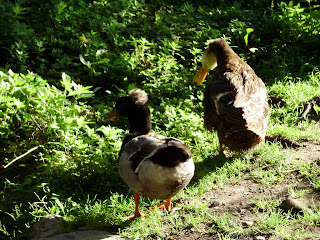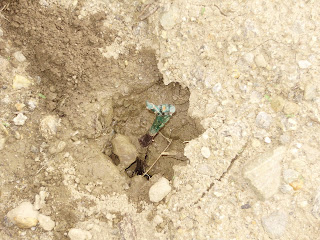



 So, let me introduce you to Brunnenburg Castle, Agricultural Museum. Here is a way for people to see what agriculture is like in the Alps. They have historical equipment and heritage breed animals. Because of the slope, special tools may be used in unique ways to grow food and support livestock in these beautiful mountains. Here is a view from where the animals live of the castle that I live next to (there are several at Brunnenburg). In this castle there are apartments for Nona (grandmother), Nik (my "boss"), and other family members.
So, let me introduce you to Brunnenburg Castle, Agricultural Museum. Here is a way for people to see what agriculture is like in the Alps. They have historical equipment and heritage breed animals. Because of the slope, special tools may be used in unique ways to grow food and support livestock in these beautiful mountains. Here is a view from where the animals live of the castle that I live next to (there are several at Brunnenburg). In this castle there are apartments for Nona (grandmother), Nik (my "boss"), and other family members.
 This is the courtyard that goes up to my room.
This is the courtyard that goes up to my room. This is the view a few steps out my front door - you guessed it! Another castle.
This is the view a few steps out my front door - you guessed it! Another castle. Here is to the left, showing how productive the little village of Sudtirol is! They are some of the biggest producers of apples and grapes in Italy! What a wonderful way to live!
Here is to the left, showing how productive the little village of Sudtirol is! They are some of the biggest producers of apples and grapes in Italy! What a wonderful way to live! While exploring I found this beautiful part of the castle! Notice anything magnificent about this place? There is a tree growing IN the castle! How fantastic!
While exploring I found this beautiful part of the castle! Notice anything magnificent about this place? There is a tree growing IN the castle! How fantastic! Here is one of the many "secret staircases" in the castle. Its so much fun when you find one! Everything is on the edge, so views are spectacular.
Here is one of the many "secret staircases" in the castle. Its so much fun when you find one! Everything is on the edge, so views are spectacular. This is the view from that lovely cedar tree growing in the castle balcony.
This is the view from that lovely cedar tree growing in the castle balcony.
Heritage Breeds on the farm:
This is Mira and Bella, the two Mangalitsa Swein. They are woolly pigs! They are wonderful girls, the love scratches, peanuts, and to go for walks! (They have a boyfriend too, but he's staying in the hut in the picture).
This breed was originally bred in Hungary and are endangered. Austria currently has a breeding program where Brigitte and Sizzo got Mira and Bella from. Both are going to farrow (have piglets) later this summer. They should have 4 - 6 piglets each. 

The term "heritage breed" refers livestock old breeds of livestock that are usually in danger of becoming extinct. Before simple and fast transportation, many regions could have more than 20 breeds of one kind of livestock (be it goat or pig) that was acclimated to the certain area. They would be resistant to local parasites, do well on little or poor, local forage, and be manageable on a small farm. They did not have a lot of offspring and were not high producers like today's breeds in modern agriculture. It simply was not needed on a small homestead. Mira, Bella, and Gulliver (the pigs) originated in Hungary and are being bred mainly in Austria now, they are a fairly local breed, here in Dorf Tirol. The goats are originally from the Tirol region, and the poultry here are all alpine breeds as well
Breeding heritage varieties of livestock is improving the genetic diversity of that breed. Having a diversity of breeds promotes biodiversity, which is important for many reasons. Biodiversity is a major concern in the environmental movement with conservation projects as well. There are also other heritage breeds on this farm, so stay tuned for more pictures.
Viticulture, Lesson 1: planting new vines
Grape growing starts with a new vineyard. Over the winter Nik, his family and friends, built stone walls to reinforce a new vineyard. Below is the finished product (before vines). Nik showed a friend (Miche) and I how to finish straightening the posts before he put the wire in.
These particular grapes came by mail in this box, and were stored in a moist, cool environment until we could take them out for planting. This is a new variety that Nik is going to work with this year that is fungi-resistant. He will be able to see what kind of wine it makes after harvest in about three years.
The tops of these grapes are green, they were sealed with wax when they were sent to keep them sterile and keeps them from being damaged. There are buds poking through on many of these vines - they are ready to be out in the sun!




Thank you for reading about my trip to Italy. I will post again before I leave and I hope you email me with any questions while I am here. As you can see - I'm having a blast!


